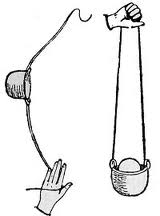
 |
|
Back to the Anglo Saxon Survival Guide Index |
 An Anglo Saxon archer. Continuing my discussion of arms and armour used in Anglo Saxon times I am looking at missiles. This material is adapted from Richard Underwood’s book Anglo Saxon Weapons and Warfare which I refered to when writing The Amber Treasure. It is recommended for those wishing detail on this subject. a)Javelin.
Although spears could be used as a missile weapon, their bulk and weight would make them of limited value and certainly very restricted range. Lighter and shorter, the javelin was much more adapted for this purpose. From the account of the Battle of Maldon in 991 it appears that an exchange of javelins was a prelude to the main melee. Javelins had a range of perhaps 50 feet. Angons were a sub class of javelin with barbs on the head which would be difficult to pull out of a wound. One drawback to the javelin is the problem that your enemy could pick it up and throw it back at you. The Romans got round this problem in the construction of their pilums so that the heads would bend and buckle and be no use (but could be repaired after a battle). There is some suggestion in the Grettir’s Saga that the Anglo Saxons tried experiments with loosening the screws that held the head to the shaft but this was not very successful.
b) The Bow.
Finding of bows in the graves of the period is rare. Does this suggest they were not widely used? Probably not. It is more likely that wood and sinews that were used in the construction of bows would not survive well in the soil of England into today. Sometimes grave goods including bows do survive well enough for us to see what type of bows were constructed. Furthermore the sagas record the use of bows and in particular the Bayeux tapestry shows no less than 29 images of archers suggesting bows were is use. Most men would use bows in hunting and so the use of the weapon would have been familiar. That said, a man encumbered with armour and shield does not make a good archer and so the bulk of an Anglo Saxon warband would not be bow armed for this practical reason. The arrow heads that survive show a variety of shapes suggesting the Anglo Saxons attempted to make them for different purposes just as later 100 years wars archers did. Thus we can identify broad lead shaped arrow heads, narrow points good for armour piercing and barbed arrows. Bows at this time period would have range of about 500 feet.
c)The Francisca or throwing axe.
The 6th century chronicler Gregory of Tours records the use of small, curved headed throwing axes by the Franks (after whom they are named, becoming in time the French). Very limited in range (about 40 feet), these weapons were used at close range to shatter shields and disrupt the shield wall before the final charge.
d)Sling.
There is very little evidence of the use of the sling in warfare although one image in the Bayeux tapestry does show a man hunting with a sling. It is likely that men would carry a sling and stones for hunting and so it might on occasion be used in battle. In The Amber Treasure, Cuthbert is a superb archer and I give accounts of his and other skirmishers activities in battle. .
|
 left: An Angon
left: An Angon







